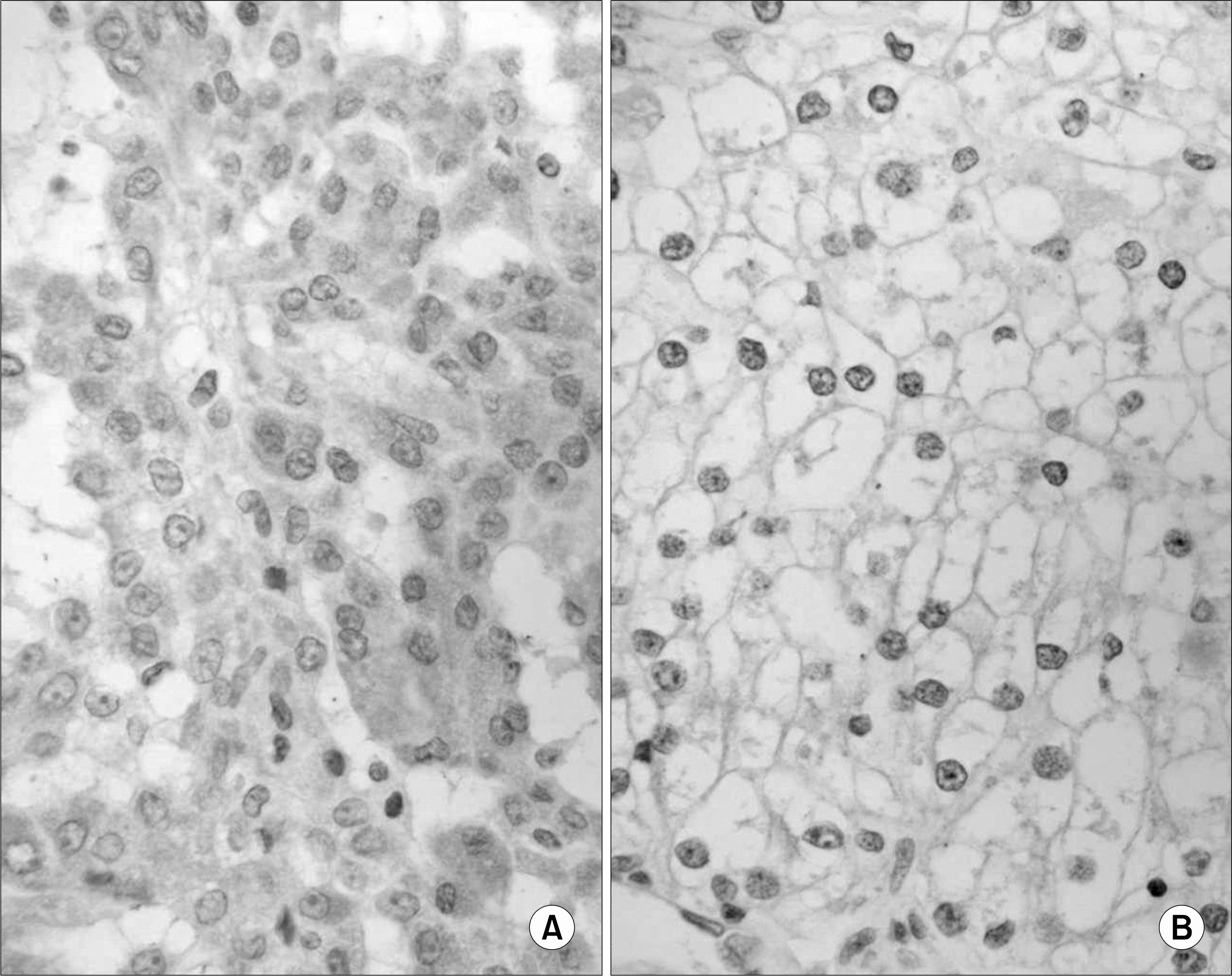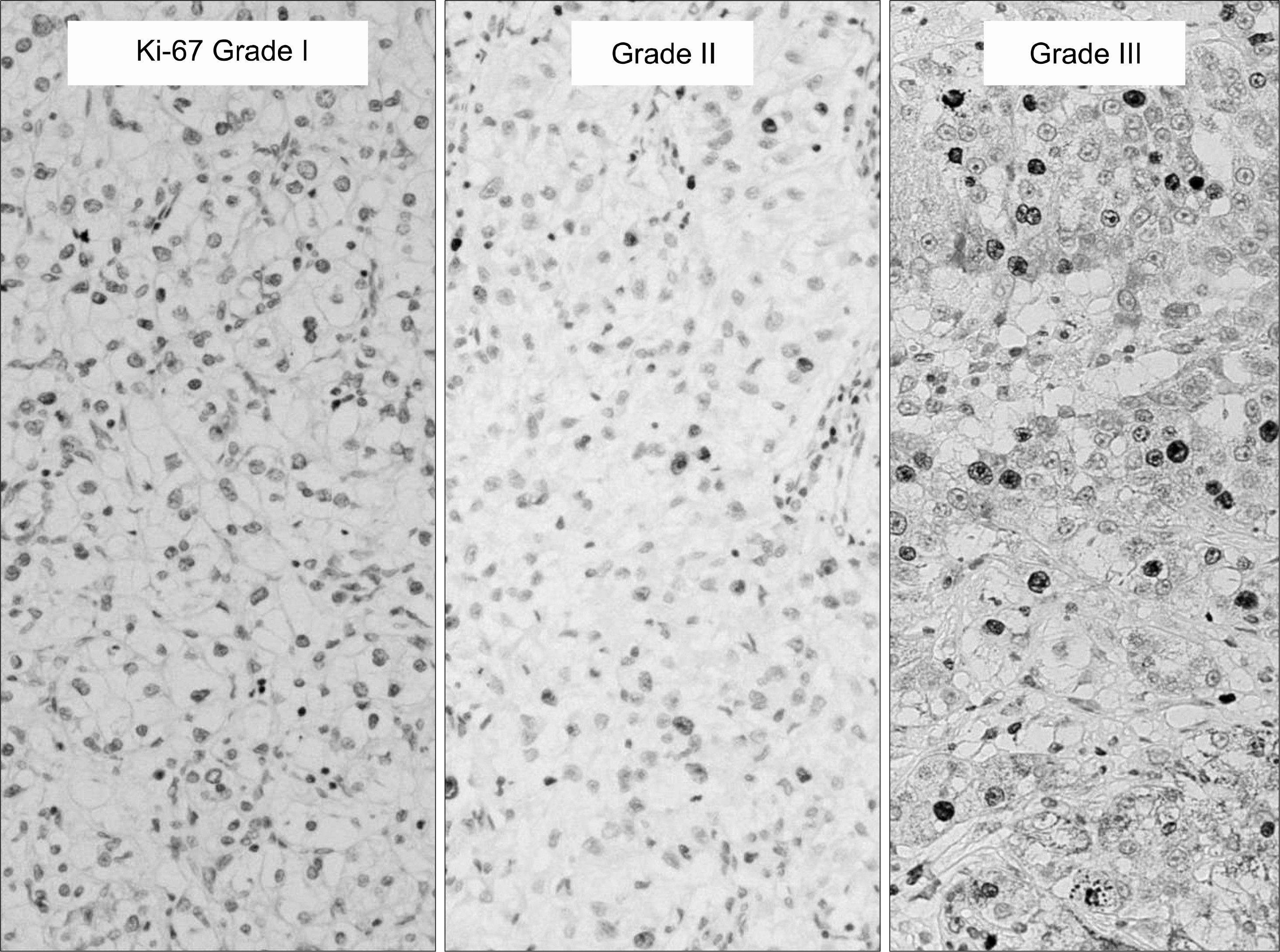Korean J Urol.
2008 Feb;49(2):99-106.
Caveolin-1 and Ki-67 Expression as Prognostic Factors in Clear Cell Carcinoma of the Kidney
- Affiliations
-
- 1Dalseong-gun Public Health Center, Daegu, Korea. chp@dsmc.or.kr
- 2Department of Urology, Keimyung University School of Medicine, Daegu, Korea.
Abstract
-
PURPOSE: Caveolin-1 is proposed to represent a novel tumor suppressor protein and expression of recombinant caveolin-1 is sufficient to restrict the growth potential of transformed cells isolated from primary tumors of the breast, lung, and ovaries. We examined the relationship of caveolin-1 and Ki-67 expression to clinicopathological variables in patients with clear cell carcinomas of the kidney.
MATERIALS AND METHODS
We examined caveolin-1 and Ki-67 expression in 119 clear cell carcinomas of the kidney using immunohistochemistry, and analyzed its relationship with tumor size, nuclear grade, TNM stage, vascular invasion, capsular invasion, metastasis, and metachronous metastasis were investigated.
RESULTS
Of the 119 tumors analyzed, lymph node and distant metastasis (synchronous metastasis: 7, metachronous metastasis: 15) occurred in 3 and 22 cases, respectively. Caveolin-1 expression correlated with the T stage(p=0.004), TNM stage(p=0.013), metastasis(p=0.013), and metachronous metastasis(p=0.001). Ki-67 expression correlated with the T stage(p=0.041), nuclear grade(p=0.011), and vascular invasion(p=0.043). Caveolin-1 and Ki-67 expression showed similar changes, but there was no statistical significance(p=0.050).
CONCLUSIONS
Caveolin-1 is expressed frequently in patients with metachronous metastasis, and may predict metastasis after surgery for clear cell carcinoma of the kidney.
MeSH Terms
Figure
Reference
-
1. Anderson RG. Caveolae: where incoming and outgoing messengers meet. Proc Natl Acad Sci USA. 1993; 90:10909–13.
Article2. Yang G, Truong LD, Timme TL, Ren C, Wheeler TM, Park SH, et al. Elevated expression of caveolin is associated with prostate and breast cancer. Clin Cancer Res. 1998; 4:1873–80.3. Kato K, Hida Y, Miyamoto M, Hashida H, Shinohara T, Itoh T, et al. Overexpression of caveolin-1 in esophageal squamous cell carcinoma correlates with lymph node metastasis and pathologic stage. Cancer. 2002; 94:929–33.
Article4. Guinan P, Sobin LH, Algaba F, Badellino F, Kameyama S, MacLennan G, et al. TNM staging of renal cell carcinoma: Workgroup No. 3. Union International Contre le Cancer (UICC) and the American Joint Committee on Cancer (AJCC). Cancer. 1997; 80:992–3.5. Fuhrman SA, Lasky LC, Limas C. Prognostic significance of morphologic parameters in renal cell carcinoma. Am J Surg Pathol. 1982; 6:655–63.
Article6. Anderson RG. The caveolae membrane system. Annu Rev Biochem. 1998; 67:199–225.
Article7. Scherer PE, Lewis RY, Volonte D, Engelman JA, Galbiati F, Couet J, et al. Cell-type and tissue-specific expression of caveolin-2. Caveolin 1 and 2 co-localize and form a stable hetero-oligomeric complex in vivo. J Biol Chem. 1997; 272:29337–46.8. Song KS, Scherer PE, Tang Z, Okamoto T, Li S, Chafel M, et al. Expression of caveolin-3 in skeletal, cardiac, and smooth muscle cells. Caveolin-3 is a component of the sarcolemma and co-fractionates with dystrophin and dystrophin-associated glycoproteins. J Biol Chem. 1996; 271:15160–5.9. Okamoto T, Schlegel A, Scherer PE, Lisanti MP. Caveolins, a family of scaffolding proteins for organizing “preassembled signaling complexes” at the plasma membrane. J Biol Chem. 1998; 273:5419–22.
Article10. Davidson B, Nesland JM, Goldberg I, Kopolovic J, Gotlieb WH, Bryne M, et al. Caveolin-1 expression in advanced-stage ovarian carcinoma-a clinicopathologic study. Gynecol Oncol. 2001; 81:166–71.11. Lee SW, Reimer CL, Oh P, Campbell DB, Schnitzer JE. Tumor cell growth inhibition by caveolin re-expression in human breast cancer cells. Oncogene. 1998; 16:1391–7.
Article12. Smart EJ, Graf GA, McNiven MA, Sessa WC, Engelman JA, Scherer PE, et al. Caveolins, liquid-ordered domains, and signal transduction. Mol Cell Biol. 1999; 19:7289–304.
Article13. Wiechen K, Sers C, Agoulnik A, Arlt K, Dietel M, Schlag PM, et al. Down-regulation of caveolin-1, a candidate tumor suppressor gene, in sarcomas. Am J Pathol. 2001; 158:833–9.
Article14. Galbiati F, Volonte D, Engelman JA, Watanabe G, Burk R, Pestell RG, et al. Targeted downregulation of caveolin-1 is sufficient to drive cell transformation and hyperactivate the p42/44 MAP kinase cascade. EMBO J. 1998; 17:6633–48.
Article15. Bender FC, Reymond MA, Bron C, Quest AF. Caveolin-1 levels are down-regulated in human colon tumors, and ectopic expression of caveolin-1 in colon carcinoma cell lines reduces cell tumorigenicity. Cancer Res. 2000; 60:5870–8.16. Fiucci G, Ravid D, Reich R, Liscovitch M. Caveolin-1 inhibits anchorage-independent growth, anoikis and invasiveness in MCF-7 human breast cancer cells. Oncogene. 2002; 21:2365–75.
Article17. van Deurs B, Roepstorff K, Hommelgaard AM, Sandvig K. Caveolae: anchored, multifunctional platforms in the lipid ocean. Trends Cell Biol. 2003; 13:92–100.18. Yang G, Truong LD, Wheeler TM, Thompson TC. Caveolin-1 expression in clinically confined human prostate cancer: a novel prognostic marker. Cancer Res. 1999; 59:5719–23.19. Rajjayabun PH, Garg S, Durkan GC, Charlton R, Robinson MC, Mellon JK. Caveolin-1 expression is associated with high-grade bladder cancer. Urology. 2001; 58:811–4.
Article20. Fine SW, Lisanti MP, Galbiati F, Li M. Elevated expression of caveolin-1 in adenocarcinoma of the colon. Am J Clin Pathol. 2001; 115:719–24.
Article21. Oh W, Bae EK, Youn SS, Ahn KS, Choi HY. Increased expression of caveolin-1 in renal cell carcinoma. Korean J Urol. 2000; 41:602–8.22. Joo HJ, Oh DK, Kim YS, Lee KB, Kim SJ. Increased expression of caveolin-1 and microvessel density correlates with metastasis and poor prognosis in clear cell renal cell carcinoma. BJU Int. 2004; 93:291–6.
Article23. Campbell L, Gumbleton M, Griffiths DF. Caveolin-1 overex-pression predicts poor disease-free survival of patients with clinically confined renal cell carcinoma. Br J Cancer. 2003; 89:1909–13.
Article24. Shim HY, Choi HY. Correlation between up-regulation of caveolin-1 gene in human renal cell carcinoma and multi-drug resistance. Korean J Urol. 2003; 44:446–51.25. Carrion R, Morgan BE, Tannenbaum M, Salup R, Morgan MB. Caveolin expression in adult renal tumors. Urol Oncol. 2003; 21:191–6.
Article26. Won YY, Joo HJ, Cho DS, Seo KS, Ahn BC, Kim KH, et al. Correlation of caveolin-1 expression on tissue microarray with prognosis in renal cell carcinoma. Korean J Urol. 2006; 47:607–6.
Article27. Mellon K, Neal DE, Robinson MC, Marsh C, Wright C. Cell cycling in bladder carcinoma determinated by monoclonal antibody Ki67. Br J Urol. 1990; 66:281–5.28. Papadopoulos I, Weichert-Jacobsen K, Wacker HH, Sprenger E. Correlation between DNA ploidy, proliferation marker Ki-67 and early tumor progression in renal cell carcinoma. A prospective study. Eur Urol. 1997; 31:49–53.29. Delahunt B, Bethwaite PB, Thornton A, Ribas JL. Proliferation of renal cell carcinoma assessed by fixation-resistant poly-clonal Ki-67 antibody labeling. Correlation with clinical outcome. Cancer. 1995; 75:2714–9.
Article30. Tannapfel A, Hahn HA, Katalinic A, Fietkau RJ, Kühn R, Wittekind CW. Prognostic value of ploidy and proliferation markers in renal cell carcinoma. Cancer. 1996; 77:164–71.
Article
- Full Text Links
- Actions
-
Cited
- CITED
-
- Close
- Share
- Similar articles
-
- Correlation of Caveolin-1 Expression on Tissue Microarray with Prognosis in Renal Cell Carcinoma
- Correlation of Clinical Stage and Presumptive Prognostic Factors in Renal Cell Carcinoma
- The Relationship of Clusterin Expression with Ki-67 Expression and Clinicopathological Factors in Human Renal Cell Carcinoma
- Diagnostic Utility of Caveolin-1 and MOC-31 in Distinguishing Chromophobe Renal Cell Carcinoma from Renal Oncocytoma
- Increased Expression of Caveolin-1 in Renal Cell Carcinoma



